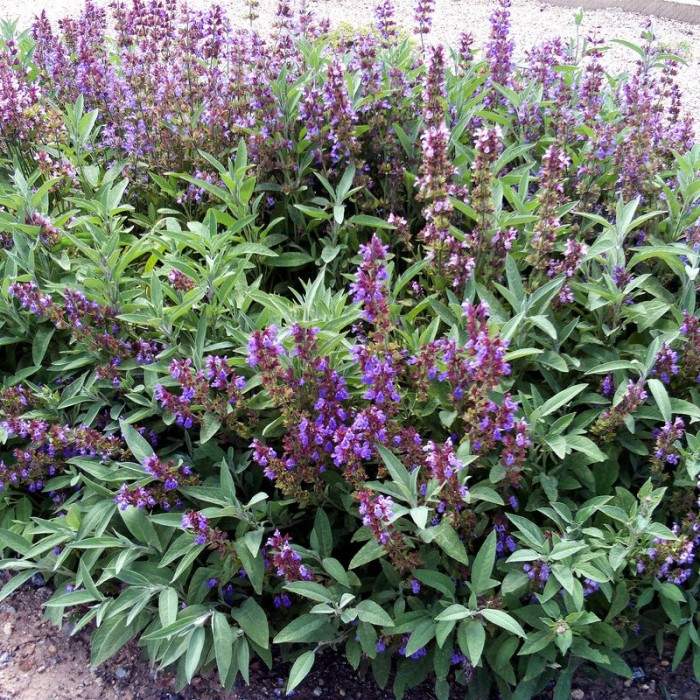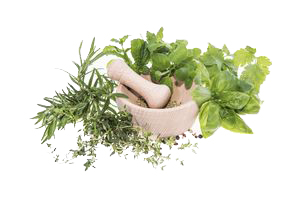Sage common / Salvia officinalis - is a perennial herbaceous plant with a height of 20-70 cm or a shrub up to 75 cm high, the Lamiaceae family, the genus Sage (Salvia).
Sage common - is a good honey plant; in favorable warm and humid weather, it abundantly secretes odorous nectar [4]. In addition to nectar, it secretes glue, which is collected by bees. Honey of dark golden color, with a pleasant smell.
The use of sage common in medicine
Fresh and dried sage herb is a traditional folk remedy (infusions, decoctions). In folk medicine, sage is used as a raw material for the production of tinctures, as well as extracts, which are then introduced into medicines (Salvin). They are recommended for inflammation of the oral cavity, pharynx and tonsils, catarrh of the upper respiratory tract, toothache, as an expectorant, to strengthen the gums. In foreign medicine, the plant is also recommended for gastrointestinal inflammation, gastric ulcer, gastritis, colitis, flatulence, diarrhea, diseases of the liver, gallbladder and kidneys; as an external agent - for purulent wounds, bruises.
The essential oil of sage common is used in the perfumery and cosmetic industry for flavoring tooth powder and paste. It has been experimentally established that fatty oil from seeds is a bactericidal agent, it is used for inhalation.
The use of sage in cooking is also undeniably high. The leaves are used in the alcoholic beverage, fish, canning and food concentrate industries. They have a strong spicy smell, spicy bitter taste. It goes well with rosemary common. They season salads, soups, vegetables, meat, fish, poultry, sweet dishes. Sage gives a piquant flavor to grated cheeses and pie fillings.
Sage common is used to flavor tea, tobacco, sausages, liver products, cheese, soft drinks, and in a spicy seasoning for hare and pork, minced meat, kidney, game, and ham. The plant is used in a special way in China, brewed as a tea. In the food industry, the leaves of the plant are added to spicy and pickled herring. In many countries, dried sage is included in spice blends.
Growing sage common :
Propagated by seeds, seedlings, as well as plant division and cuttings. Sowing is carried out before winter or early spring. Sowing in open ground is carried out in March - June. For cultivation in room conditions, on the window, sowing is carried out in August - March.
Sage seeds are sown as follows: a layer of calcined sand is poured onto the soil, and seeds are sown on top. Seeds can be lightly sprinkled with sand. Sprayed from a spray bottle. Cover with foil or glass. Paper is placed on top of the film, from the sun's rays.
Germinate seeds at a temperature of 22-24C - 18-25 days. All this time it is necessary to monitor the uniformity of the moisture content of the substrate. Young embryos should never dry out! For seed germination, we recommend using a substrate with hydrogranules. It evenly provides germinating seedlings with moisture and nutrients.
After the seeds have germinated and the embryonic leaves have fully opened, the film is removed. Seedlings should be well lit. Young sprouts are protected from direct sunlight.
Soil preparation is the same as for other tilled crops. After harvesting the grain, the soil is peeled to a depth of 4-5 cm, after a month the main plowing is carried out to a depth of 25-27 cm. Then the field is harrowed and cultivated. Row spacing 70 cm. Depth of seed placement 2-4 cm, seeding rate 8 kg/ha. Shoots appear in 18-22 days. Immediately after the emergence of seedlings, ball weeding is done in the rows.
Care consists of three to four weedings and cultivations. With the formation of the second pair of true leaves, seedlings are thinned out at a distance of 20 cm. Two or three plants are left in the bouquet.
On overwintered plantations, before the beginning of spring regrowth, last year's stems are removed at a height of 5 cm from the soil surface, they are given top dressing and cultivated between rows. Further care consists in loosening the row spacing and weeding in the rows.
Salvia officinalis is grown in the spring and summer in open ground. In order to have sage greens all year round, you can also grow it in a window room.
Salvia officinalis is a light-loving culture. Sage loves light fertile soils and sunny areas. When growing indoors, water as soon as the soil dries out. Spray the plant more often. In winter, additional lighting (4500-7000 lux) stimulates a greater content of vitamins and essential oils. The day length is 12 hours. From spring to autumn, fertilize regularly once every 2 weeks.

No questions about this product, be the first and ask your question.






